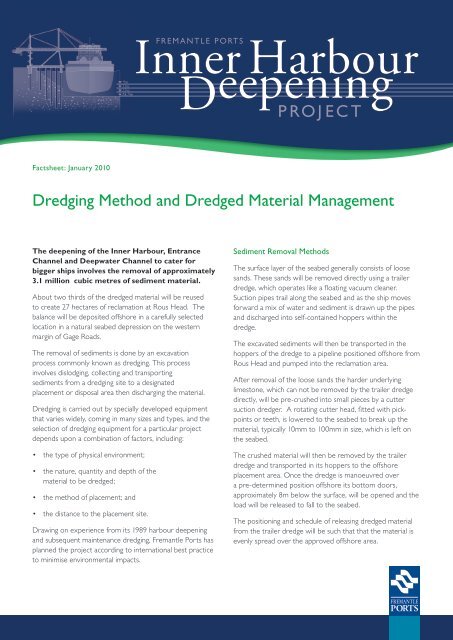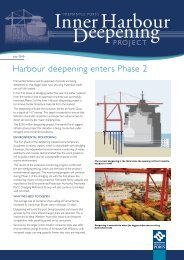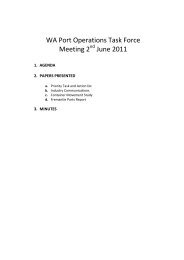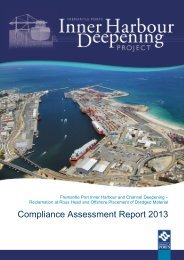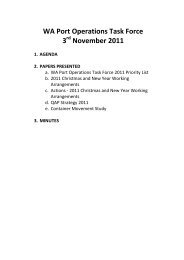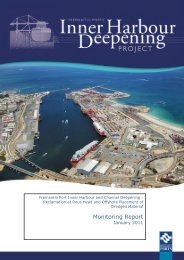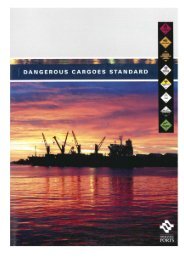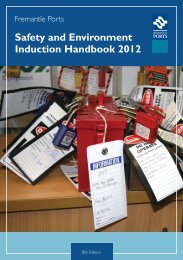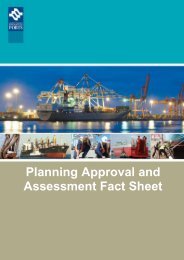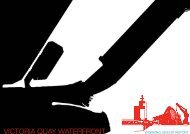IHD fact sheet - Dredging methodology January ... - Fremantle Ports
IHD fact sheet - Dredging methodology January ... - Fremantle Ports
IHD fact sheet - Dredging methodology January ... - Fremantle Ports
- No tags were found...
You also want an ePaper? Increase the reach of your titles
YUMPU automatically turns print PDFs into web optimized ePapers that Google loves.
Inner<strong>Fremantle</strong> <strong>Ports</strong>Harbour9m11m13m14.7mProjectFact<strong>sheet</strong>: <strong>January</strong> 2010<strong>Dredging</strong> Method and Dredged Material ManagementThe deepening of the Inner Harbour, EntranceChannel and Deepwater Channel to cater forbigger ships involves the removal of approximately3.1 million cubic metres of sediment material.About two thirds of the dredged material will be reusedto create 27 hectares of reclamation at Rous Head. Thebalance will be deposited offshore in a carefully selectedlocation in a natural seabed depression on the westernmargin of Gage Roads.The removal of sediments is done by an excavationprocess commonly known as dredging. This processinvolves dislodging, collecting and transportingsediments from a dredging site to a designatedplacement or disposal area then discharging the material.<strong>Dredging</strong> is carried out by specially developed equipmentthat varies widely, coming in many sizes and types, and theselection of dredging equipment for a particular projectdepends upon a combination of <strong>fact</strong>ors, including:• the type of physical environment;• the nature, quantity and depth of thematerial to be dredged;• the method of placement; and• the distance to the placement site.Drawing on experience from its 1989 harbour deepeningand subsequent maintenance dredging, <strong>Fremantle</strong> <strong>Ports</strong> hasplanned the project according to international best practiceto minimise environmental impacts.Sediment Removal MethodsThe surface layer of the seabed generally consists of loosesands. These sands will be removed directly using a trailerdredge, which operates like a floating vacuum cleaner.Suction pipes trail along the seabed and as the ship movesforward a mix of water and sediment is drawn up the pipesand discharged into self-contained hoppers within thedredge.The excavated sediments will then be transported in thehoppers of the dredge to a pipeline positioned offshore fromRous Head and pumped into the reclamation area.After removal of the loose sands the harder underlyinglimestone, which can not be removed by the trailer dredgedirectly, will be pre-crushed into small pieces by a cuttersuction dredger. A rotating cutter head, fitted with pickpointsor teeth, is lowered to the seabed to break up thematerial, typically 10mm to 100mm in size, which is left onthe seabed.The crushed material will then be removed by the trailerdredge and transported in its hoppers to the offshoreplacement area. Once the dredge is manoeuvred overa pre-determined position offshore its bottom doors,approximately 8m below the surface, will be opened and theload will be released to fall to the seabed.The positioning and schedule of releasing dredged materialfrom the trailer dredge will be such that that the material isevenly spread over the approved offshore area.
Fact<strong>sheet</strong>: <strong>January</strong> 2010Loose sand is picked up by a trailer dredge with the materialdischarged into a self-contained hopper within the dredge.Material from the hopper is pumped into the reclamation areafrom offshore via a pipeline.Hard underlying limestone is broken up by a rotating cutter head by a cuttersuction dredge. It is then then picked up by a trailer dredge.Hard material is transported in the hopper of the trailer dredge to the designatedoffshore disposal area. The bottom doors open and the material falls to the seabed.Dredged Material ManagementAround two thirds of the dredged material will be placedbehind a seawall to create further reclamation at Rous Head.As the reclamation fills, the solid sediment settles and theremaining water is returned back into the sea via a weir box.A silt curtain will surround the weir box on the seaward sideto further reduce the extent of sediment plumes.At the offshore disposal area, the hopper will dischargeits material through doors that open at the bottom of thevessel. The solid sediment particles drop through the watercolumn to the bottom of the seabed.Project contact informationIf you have any queries about the project, or would likefurther information, please contact Ainslie de Vos orLisa Rae on 08 9430 3555.1 Cliff St <strong>Fremantle</strong>, Western Australia, 6160Tel: +61 8 9430 3555 Fax: +61 8 9336 1391Website: www.fremantleports.com.auEmail: mail@fremantleports.com.au


